Unit 4 My Neighbourhood Lesson 20 No Stopping!课件 +嵌入音频(共18张PPT)
文档属性
| 名称 | Unit 4 My Neighbourhood Lesson 20 No Stopping!课件 +嵌入音频(共18张PPT) | 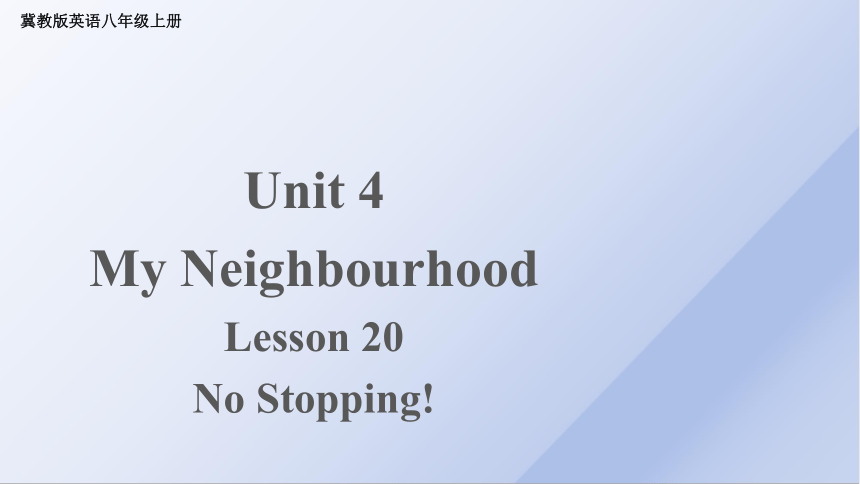 | |
| 格式 | pptx | ||
| 文件大小 | 13.8MB | ||
| 资源类型 | 教案 | ||
| 版本资源 | 冀教版 | ||
| 科目 | 英语 | ||
| 更新时间 | 2024-01-03 11:27:12 | ||
图片预览


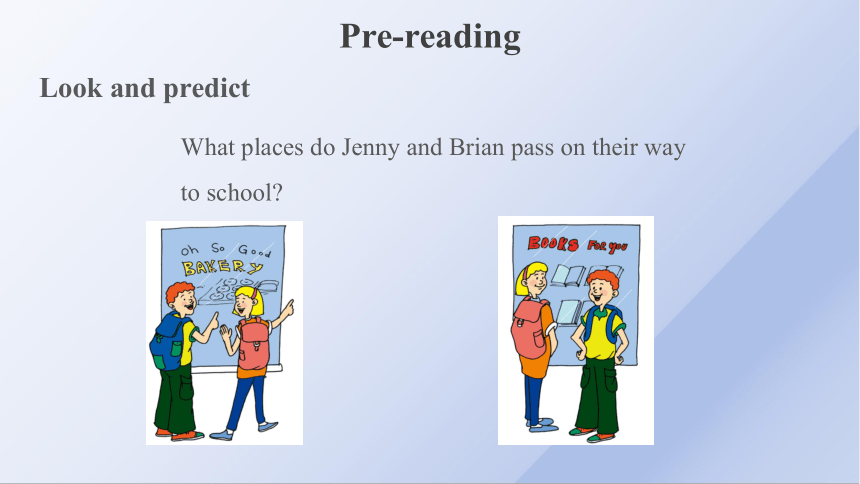
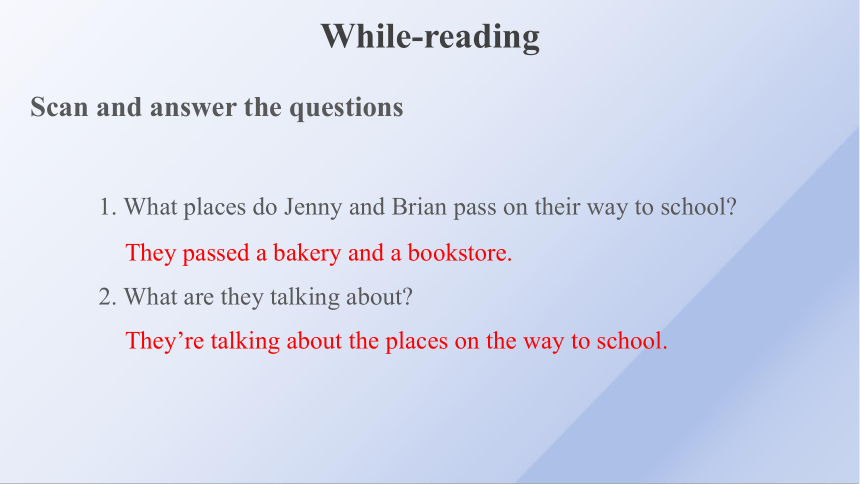
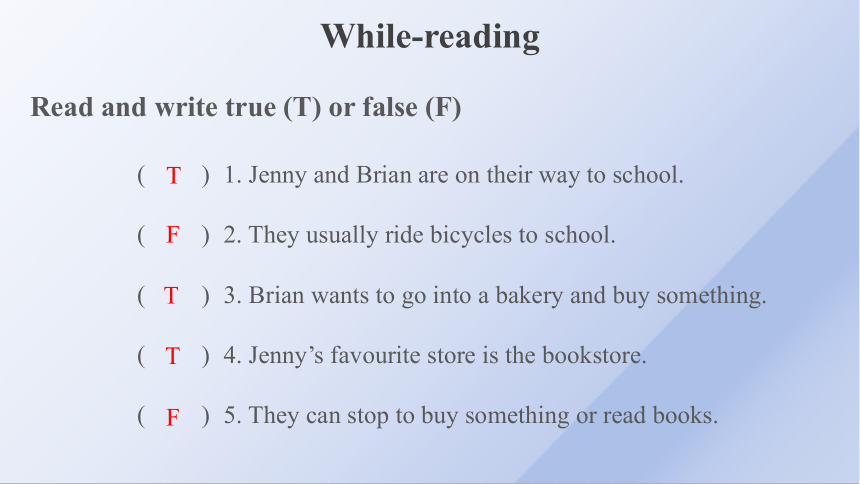
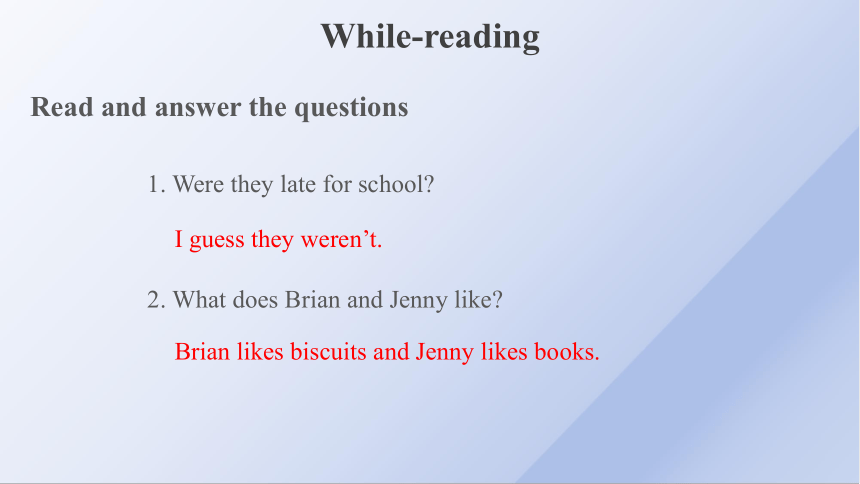
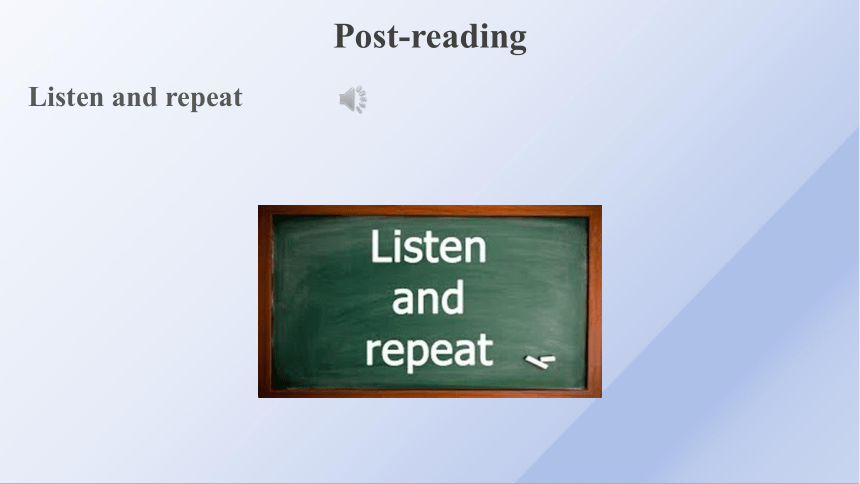
文档简介
(共18张PPT)
Unit 4
My Neighbourhood
Lesson 20
No Stopping!
冀教版英语八年级上册
Warming-up
Free talk
1. What places do you pass on your way to school
2. What will you do if you are attracted by
something interesting on your way to school
What places do Jenny and Brian pass on their way to school
Pre-reading
Look and predict
Scan and answer the questions
1. What places do Jenny and Brian pass on their way to school
2. What are they talking about
They passed a bakery and a bookstore.
They’re talking about the places on the way to school.
While-reading
( )
( )
( )
( )
( )
1. Jenny and Brian are on their way to school.
2. They usually ride bicycles to school.
3. Brian wants to go into a bakery and buy something.
4. Jenny’s favourite store is the bookstore.
5. They can stop to buy something or read books.
T
T
T
F
F
Read and write true (T) or false (F)
While-reading
1. Were they late for school
2. What does Brian and Jenny like
I guess they weren’t.
Read and answer the questions
Brian likes biscuits and Jenny likes books.
While-reading
Listen and repeat
Post-reading
1. Jenny and Brian are on their way to school.
詹妮和布莱恩正在去学校的路上。
on one’s/the way to意为“在去某地的路上”,如后加副词,
则没有to。on his way home在他回家的路上
e.g. On my way to the bookstore, I found a wallet on the ground.
在去书店的路上,我在地上发现了一个钱包。
Learn the language points
Post-reading
2. Usually we take the school bus.
通常我们乘坐校车。
take a bus和by bus都表示“乘公共汽车”,前者是动词作
谓语,后者是介词短语作状语。
e.g. I take a bus to the supermarket.
我乘公共汽车去超市。
Do you come to school by bus
你乘公共汽车上学吗
Post-reading
3. He is pointing to the right.
他正指着右边。
point to与point at都有“指……” 的含义,一般情况下可互换,但二者侧
重点不同。point to侧重指的方向,意为“指向”;point at侧重指的对象,
意为“指着”。如果表述的内容强调对象就用point at;如果强调方向,则
用point to。但事物名词作主语时,用point to要常见些。
e.g. It is rude to point at a person.
指着人是失礼的。
The building points to the east.
这所大楼朝东。
Post-reading
4. Soon they walk past a big store window.
很快,他们走过一扇大的商店的橱窗。
past prep. 过……
adj. 过去的;刚过去的
v. 经过
e.g. We went past a school. 我们经过了一所学校。
He has been ill for the past few days. 几天来他一直病着。
Post-reading
Fill in the blanks
1. I want to show you the ______________ this morning.
2. “Do we go this way now ” asks Brian. He is ________ to the right.
3. They look left, then right. They ________ the street.
4. We will go ________ some of my favourite shops.
neighbourhood
pointing
cross
past
Post-reading
Match the statements with the reasons
Post-reading
魔法记忆
You can ask the following questions:
How do you usually get to school
What places do you pass on your way to school
What are your favourite places
Do you stop anywhere Why or why not
Work in pairs. Talk about what you do on your way to school. Then make up a dialogue with your partner.
Make up a dialogue
Post-reading
魔法记忆
Li Ming: Hi, Wang Wei! How do you usually get to school
Wang Wei: I usually walk to school. Sometimes I go to school by bike.
Li Ming: What places do you pass on your way to school
Wang Wei: I go past a bookstore, a bakery, a toy store and a flower shop.
Li Ming: What are your favourite places
Wang Wei: The bookstore and the toy store.
Li Ming: Do you stop anywhere Why
Wang Wei: Sometimes I will stop. I will go to buy some books. Books are my favourite.
A possible version
Post-reading
Summary
Key words and phrases:
biscuit, go past/by, tea biscuit
Key sentences:
1. Jenny and Brian are on their way to school.
2. Usually we take the school bus.
3. He is pointing to the right.
4. Soon they walk past a big store window.
Homework
1. Review and recite the important points of this lesson.
2. Read the text after class.
3. Write the dialogue made in class.
Thank you!
Unit 4
My Neighbourhood
Lesson 20
No Stopping!
冀教版英语八年级上册
Warming-up
Free talk
1. What places do you pass on your way to school
2. What will you do if you are attracted by
something interesting on your way to school
What places do Jenny and Brian pass on their way to school
Pre-reading
Look and predict
Scan and answer the questions
1. What places do Jenny and Brian pass on their way to school
2. What are they talking about
They passed a bakery and a bookstore.
They’re talking about the places on the way to school.
While-reading
( )
( )
( )
( )
( )
1. Jenny and Brian are on their way to school.
2. They usually ride bicycles to school.
3. Brian wants to go into a bakery and buy something.
4. Jenny’s favourite store is the bookstore.
5. They can stop to buy something or read books.
T
T
T
F
F
Read and write true (T) or false (F)
While-reading
1. Were they late for school
2. What does Brian and Jenny like
I guess they weren’t.
Read and answer the questions
Brian likes biscuits and Jenny likes books.
While-reading
Listen and repeat
Post-reading
1. Jenny and Brian are on their way to school.
詹妮和布莱恩正在去学校的路上。
on one’s/the way to意为“在去某地的路上”,如后加副词,
则没有to。on his way home在他回家的路上
e.g. On my way to the bookstore, I found a wallet on the ground.
在去书店的路上,我在地上发现了一个钱包。
Learn the language points
Post-reading
2. Usually we take the school bus.
通常我们乘坐校车。
take a bus和by bus都表示“乘公共汽车”,前者是动词作
谓语,后者是介词短语作状语。
e.g. I take a bus to the supermarket.
我乘公共汽车去超市。
Do you come to school by bus
你乘公共汽车上学吗
Post-reading
3. He is pointing to the right.
他正指着右边。
point to与point at都有“指……” 的含义,一般情况下可互换,但二者侧
重点不同。point to侧重指的方向,意为“指向”;point at侧重指的对象,
意为“指着”。如果表述的内容强调对象就用point at;如果强调方向,则
用point to。但事物名词作主语时,用point to要常见些。
e.g. It is rude to point at a person.
指着人是失礼的。
The building points to the east.
这所大楼朝东。
Post-reading
4. Soon they walk past a big store window.
很快,他们走过一扇大的商店的橱窗。
past prep. 过……
adj. 过去的;刚过去的
v. 经过
e.g. We went past a school. 我们经过了一所学校。
He has been ill for the past few days. 几天来他一直病着。
Post-reading
Fill in the blanks
1. I want to show you the ______________ this morning.
2. “Do we go this way now ” asks Brian. He is ________ to the right.
3. They look left, then right. They ________ the street.
4. We will go ________ some of my favourite shops.
neighbourhood
pointing
cross
past
Post-reading
Match the statements with the reasons
Post-reading
魔法记忆
You can ask the following questions:
How do you usually get to school
What places do you pass on your way to school
What are your favourite places
Do you stop anywhere Why or why not
Work in pairs. Talk about what you do on your way to school. Then make up a dialogue with your partner.
Make up a dialogue
Post-reading
魔法记忆
Li Ming: Hi, Wang Wei! How do you usually get to school
Wang Wei: I usually walk to school. Sometimes I go to school by bike.
Li Ming: What places do you pass on your way to school
Wang Wei: I go past a bookstore, a bakery, a toy store and a flower shop.
Li Ming: What are your favourite places
Wang Wei: The bookstore and the toy store.
Li Ming: Do you stop anywhere Why
Wang Wei: Sometimes I will stop. I will go to buy some books. Books are my favourite.
A possible version
Post-reading
Summary
Key words and phrases:
biscuit, go past/by, tea biscuit
Key sentences:
1. Jenny and Brian are on their way to school.
2. Usually we take the school bus.
3. He is pointing to the right.
4. Soon they walk past a big store window.
Homework
1. Review and recite the important points of this lesson.
2. Read the text after class.
3. Write the dialogue made in class.
Thank you!
同课章节目录
- Unit 1 Me and My Class
- Lesson 1 Back to School!
- Lesson 2 Many Faces, One Picture
- Lesson 3 Getting to Know You!
- Lesson 4 Best Friends
- Lesson 5 Meet Ms. Liu
- Lesson 6 Jenny's Week
- Unit 2 My Favourite School Subject
- Lesson 7 Don't Be Late for Class!
- Lesson 8 E-mail Helpers!
- Lesson 9 I Don't Want to Miss Geography !
- Lesson 10 Looking for Lisa
- Lesson 11 Lily Learns about China !
- Lesson 12 Karen's Hair Stood Up!
- Unit Review
- Unit 3 Families Celebrate Togethe
- Lesson 13 I Love Autumn
- Lesson 14 Happy Memories
- Lesson 15 A Present for Li Ming!
- Lesson 16 Happy Thanksgiving!
- Lesson 17 Presents from Canada!
- Lesson 18 Li Ming's Birthday
- Unit Review
- Unit 4 My Neighbourhood
- Lesson 19 The Best Neighourhood
- Lesson 20 No Stopping!
- Lesson 21 Eat a Donut and Turn Right
- Lesson 22 I Like My Neighbourhood
- Lesson 23 People in My Neighbourhood
- Lesson 24 I Need a Map!
- Unit Review
- Unit 5 My Future
- Lesson 25 I Want to Be a Teacher!
- Lesson 26 What Will I Be ?
- Lesson 27 What's Your Advice?
- Lesson 28 Rich or Poor? It Doesn't Matter!
- Lesson 29 Our Ambitions and Dreams
- Lesson 30 A Famous Friend?
- Unit Review
- Unit 6 Go With Transportation !
- Lesson 31 How Do You Travel ?
- Lesson 32 Trains Go Faster !
- Lesson 33 Life on Wheels
- Lesson 34 Flying Donuts
- Lesson 35 Future Transportation
- Lesson 36 Clean Cars ?
- Unit Review
- Unit 7 Enjoy Your Hobby
- Lesson 37 What's Your Hobby ?
- Lesson 38 Hobbies Are Fun!
- Lesson 39 Danny's Hobby
- Lesson 40 What's Paul's Hobby?
- Lesson 41 Show and Tell!
- Lesson 42 The New Club
- Unit Review
- Unit 8 Celebrating Me
- Lesson 43 What Makes You Unique?
- Lesson 44 Georgia Plays Basketball
- Lesson 45 Be Yourself !
- Lesson 46 My Dream
- Lesson 47 I Made It !
- Lesson 48 Li Ming's Report
- Unit Review
